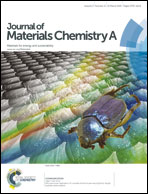Facile fabrication of graphene–polypyrrole–Mn composites as high-performance electrodes for capacitive deionization†
Abstract
Three-dimensional reduced graphene oxide–polypyrrole–MnO2 (RGO–PPy–Mn) composites are facilely prepared by a two-step hydrothermal process. Pyrrole (Py) monomers are polymerized to PPy by KMnO4 in the presence of graphene oxide (GO), and then MnO2 is obtained simultaneously after redox reaction between graphene and KMnO4 to produce RGO–PPy–Mn composites. The influences of the mass ratio of Py to GO and the mole ratio of KMnO4 to Py on RGO–PPy–Mn composites are investigated. The resultant composites exhibit a hierarchical porous structure with a specific surface area of 331 m2 g−1 and excellent specific capacity of 356 F g−1, much higher than those of pure RGO or PPy electrodes. Enhanced electrochemical capacity and low inner resistance endow RGO–PPy–Mn composite electrodes with an outstanding specific electrosorptive capacity of 18.4 mg g−1. Furthermore, RGO–PPy–Mn composite electrodes have good rate stability and cycling stability for capacitive deionization applications.


 Please wait while we load your content...
Please wait while we load your content...